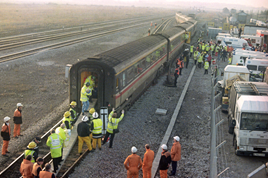The conductor also told him that directly behind them and also on the Down line there was a two-car Class 155 Sprinter with a badly injured driver. At this point Robertson made a second phone call requesting emergency services, before returning to the HST to assess the condition of its 129 passengers and await further instruction.
The second train was the 0700 Regional Railways Portsmouth Harbour-Cardiff service that had followed the HST into the tunnel at approximately 1026. It had 168 passengers and two employees aboard, including conductor Brian Nicholl.
He told the subsequent accident inquiry that the train was running about 20 minutes late, and had not long since stopped at Patchway, when it slowed down to walking pace at the English end of the tunnel near Pilning. When the engines changed tone he concluded that the signal must have been red but had then turned to green, and the Class 155 started to pick up speed as it descended into the tunnel.
Continuing in his ticket inspection duties, Nicholl estimated that the Sprinter was travelling at 30mph when he was thrown in the air by a violent impact a few minutes later. Shaken but fortunately uninjured, he made his way to the cab to check on driver Stephen Carpenter, and on hearing a faint response sprang into action to protect his train.
Having placed track circuit-operating clips on the tracks in accordance with regulations (despite no track circuit operating in the tunnel), Nicholl found a telephone 200 yards away and told the signalman there had been a serious accident. He also gave the location tally number of the phone.
On re-entering the train, which had lost power and was illuminated by emergency lighting, he used the PA to call for medical assistance, and a doctor and several nurses came forward to treat the most badly injured. These included the driver, who was trapped behind a door jammed shut by the buckling of the cab floor. This was eventually forced open, and he was discovered to be badly bleeding from facial wounds and a fractured skull inflicted by a wall-mounted fire extinguisher that had been propelled from its fixings.
Among the passengers, one person was in a critical condition with a broken leg and suffering shock from blood loss, two or three had broken arms, four people had spinal injuries, and an estimated 75 had assorted facial injuries such as broken jaws and lacerations caused by falling luggage and being thrown out of their seats.
There were less serious injuries sustained
on the HST, but across both trains there were now at least 88 people who would go on to need hospital treatment, sat trembling in the cold and dark waiting for the emergency services to arrive.
British Rail had made some provision for emergency arrangements in the event of an incident occurring over 200 feet beneath the surface in the depths of Severn Tunnel.
An emergency train was stabled at Sudbrook Pumping Station, and on the English side agreements were in place to make a service diesel multiple unit (DMU) rapidly available for emergency use. A new dedicated command and control centre had recently been provided at Sudbrook for use by emergency services, while emergency drills had been practised in September 1990 with another due in February 1993.
On December 7 the ‘rescue’ DMU train arrived from the English side, travelling in the Down direction on the Up line, about two hours after the accident, with a team of paramedics and other equipment. The emergency train from Sudbrook arrived shortly afterwards, having inexplicably sat at the western portal for more than an hour before being authorised by signalmen to enter the tunnel at caution, also on the Up line.
A controlled disembarkation of the Sprinter then took place, with those who could walk helped onto the HST and 17 stretcher cases also taken off. It would not be until almost four hours after the impact that driver Robertson was then finally instructed to drive his train forward and out of the tunnel at 5mph to Severn Tunnel Junction, where ambulances waited to transfer the injured onwards to hospitals throughout South Wales. The remaining passengers were taken to Caldicot Leisure Centre, and then by coach to Newport and Cardiff stations.
The damaged rolling stock was recovered from the tunnel that evening, and after inspections the following day established that no structural damage had been inflicted, the tunnel was reopened at 0530 on December 9.
The subsequent accident inquiry conducted by Her Majesty’s Railway Inspectorate focused on both the cause of the accident and why it took so long for emergency services to respond, leaving hundreds of terrified passengers trapped for a number of hours (with the risk of death had more life-threatening injuries been sustained).
The obvious question for HMRI was why the Sprinter had entered the tunnel when the HST ahead was still travelling through at caution, as it had been earlier instructed. The Sprinter driver Stephen Carpenter was advised against giving evidence by his lawyers, making it impossible for the inquiry to ascertain whether the signal changed from red to green as he approached it. Nobody else was in a position to testify, as the handsignalman had been withdrawn and the aspect was not visible to anyone else on the train.
















Login to comment
Comments
No comments have been made yet.